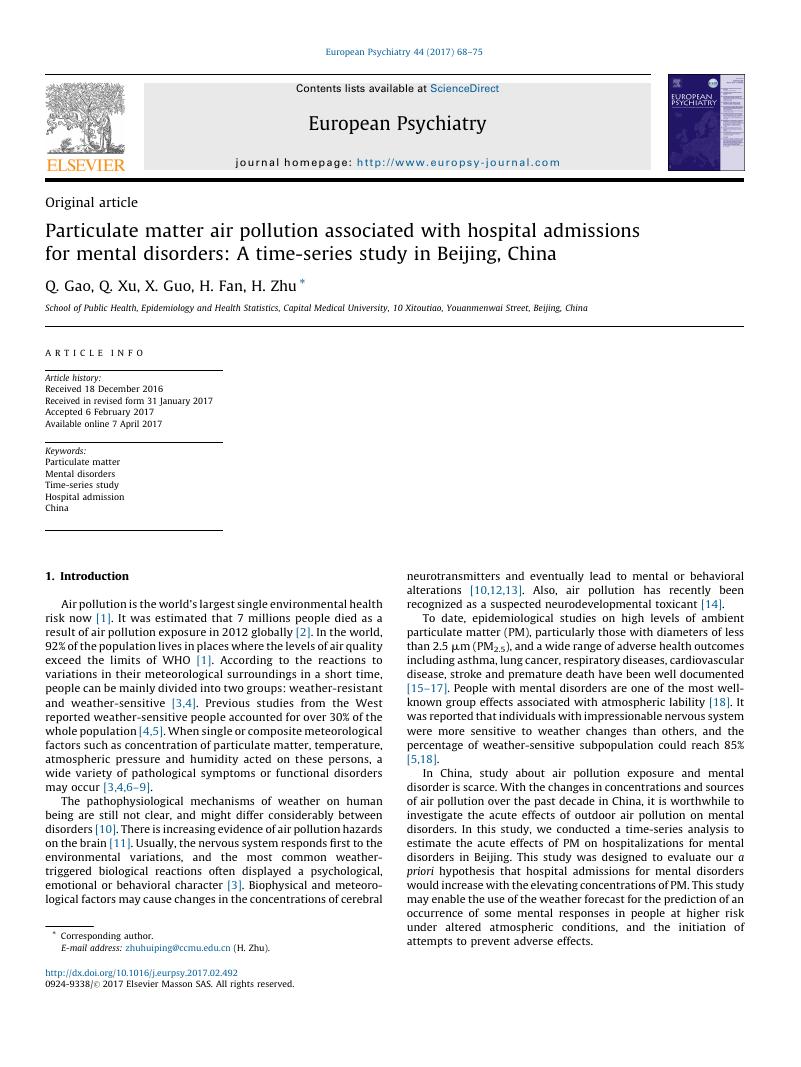Crossref Citations
This article has been cited by the following publications. This list is generated based on data provided by Crossref.
Attademo, Luigi
and
Bernardini, Francesco
2017.
Air pollution and urbanicity: common risk factors for dementia and schizophrenia?.
The Lancet Planetary Health,
Vol. 1,
Issue. 3,
p.
e90.
Bhui, Kamaldeep
2017.
Life-course psychiatry: Promoting healthy parenting, childhoods, treatment, and living space.
British Journal of Psychiatry,
Vol. 211,
Issue. 3,
p.
188.
Chen, Jiu-Chiuan
and
Samet, Jonathan Michael
2017.
Air pollution and suicide risk: another adverse effect of air pollution?.
European Journal of Epidemiology,
Vol. 32,
Issue. 11,
p.
943.
Chen, Chen
Liu, Cong
Chen, Renjie
Wang, Weibing
Li, Weihua
Kan, Haidong
and
Fu, Chaowei
2018.
Ambient air pollution and daily hospital admissions for mental disorders in Shanghai, China.
Science of The Total Environment,
Vol. 613-614,
Issue. ,
p.
324.
Song, Jie
Zheng, Liheng
Lu, Mengxue
Gui, Lihui
Xu, Dongqun
Wu, Weidong
and
Liu, Yue
2018.
Acute effects of ambient particulate matter pollution on hospital admissions for mental and behavioral disorders: A time-series study in Shijiazhuang, China.
Science of The Total Environment,
Vol. 636,
Issue. ,
p.
205.
Chan, Emily
Lam, Holly
So, Suzanne
Goggins, William
Ho, Janice
Liu, Sida
and
Chung, Phoebe
2018.
Association between Ambient Temperatures and Mental Disorder Hospitalizations in a Subtropical City: A Time-Series Study of Hong Kong Special Administrative Region.
International Journal of Environmental Research and Public Health,
Vol. 15,
Issue. 4,
p.
754.
Buoli, Massimiliano
Grassi, Silvia
Caldiroli, Alice
Carnevali, Greta Silvia
Mucci, Francesco
Iodice, Simona
Cantone, Laura
Pergoli, Laura
and
Bollati, Valentina
2018.
Is there a link between air pollution and mental disorders?.
Environment International,
Vol. 118,
Issue. ,
p.
154.
Wang, Qing
and
Yang, Zhiming
2018.
Does chronic disease influence susceptibility to the effects of air pollution on depressive symptoms in China?.
International Journal of Mental Health Systems,
Vol. 12,
Issue. 1,
Kim, Sung Hyun
Shin, Sang Do
Song, Kyoung Jun
Ro, Young Sun
Kong, So Yeon
Kim, Jeongeun
Ko, Seo Young
and
Lee, Sun Young
2019.
Association between ambient PM2.5 and emergency department visits for psychiatric emergency diseases.
The American Journal of Emergency Medicine,
Vol. 37,
Issue. 9,
p.
1649.
Braithwaite, Isobel
Zhang, Shuo
Kirkbride, James B.
Osborn, David P. J.
and
Hayes, Joseph F.
2019.
Air Pollution (Particulate Matter) Exposure and Associations with Depression, Anxiety, Bipolar, Psychosis and Suicide Risk: A Systematic Review and Meta-Analysis.
Environmental Health Perspectives,
Vol. 127,
Issue. 12,
Xue, Tao
Zhu, Tong
Zheng, Yixuan
and
Zhang, Qiang
2019.
Declines in mental health associated with air pollution and temperature variability in China.
Nature Communications,
Vol. 10,
Issue. 1,
Lee, Suji
Lee, Whanhee
Kim, Dahye
Kim, Ejin
Myung, Woojae
Kim, Sun-Young
and
Kim, Ho
2019.
Short-term PM2.5 exposure and emergency hospital admissions for mental disease.
Environmental Research,
Vol. 171,
Issue. ,
p.
313.
Ren, Ting
Yu, Xinguo
Yang, Weiwei
and
Amegah, A. Kofi
2019.
Do cognitive and non-cognitive abilities mediate the relationship between air pollution exposure and mental health?.
PLOS ONE,
Vol. 14,
Issue. 10,
p.
e0223353.
Bai, Lijun
Zhang, Xulai
Zhang, Yanwu
Cheng, Qiang
Duan, Jun
Gao, Jiaojiao
Xu, Zihan
Zhang, Heng
Wang, Shusi
and
Su, Hong
2019.
Ambient concentrations of NO2 and hospital admissions for schizophrenia.
Occupational and Environmental Medicine,
Vol. 76,
Issue. 2,
p.
125.
Newbury, Joanne B.
Arseneault, Louise
Beevers, Sean
Kitwiroon, Nutthida
Roberts, Susanna
Pariante, Carmine M.
Kelly, Frank J.
and
Fisher, Helen L.
2019.
Association of Air Pollution Exposure With Psychotic Experiences During Adolescence.
JAMA Psychiatry,
Vol. 76,
Issue. 6,
p.
614.
Qiu, Hang
Zhu, Xiaojuan
Wang, Liya
Pan, Jingping
Pu, Xiaorong
Zeng, Xiaoxi
Zhang, Li
Peng, Zhao
and
Zhou, Li
2019.
Attributable risk of hospital admissions for overall and specific mental disorders due to particulate matter pollution: A time-series study in Chengdu, China.
Environmental Research,
Vol. 170,
Issue. ,
p.
230.
Liu, Jia Jia
Wang, Feng
Liu, Hui
Wei, Ya Bin
Li, Hui
Yue, Jingli
Que, Jianyu
Degenhardt, Louisa
Lappin, Julia
Lu, Lin
Bao, Yanping
and
Wang, Jing
2019.
Ambient fine particulate matter is associated with increased emergency ambulance dispatches for psychiatric emergencies.
Environmental Research,
Vol. 177,
Issue. ,
p.
108611.
Liu, Yu
Li, Rong-Lin
Song, Yang
and
Zhang, Zhi-Jiang
2019.
The Role of Environmental Tax in Alleviating the Impact of Environmental Pollution on Residents’ Happiness in China.
International Journal of Environmental Research and Public Health,
Vol. 16,
Issue. 22,
p.
4574.
Ferrari, L.
Carugno, M.
and
Bollati, V.
2019.
Particulate matter exposure shapes DNA methylation through the lifespan.
Clinical Epigenetics,
Vol. 11,
Issue. 1,
Wei, Qiannan
Zhang, Xulai
Yi, Weizhuo
Pan, Rubing
Gao, Jiaojiao
Duan, Jun
Xu, Zihan
Cheng, Qiang
Bai, Lijun
Zhang, Yanwu
and
Su, Hong
2020.
Association between floods and hospital admissions for schizophrenia in Hefei, China: The lag effects of degrees of floods and time variation.
Science of The Total Environment,
Vol. 698,
Issue. ,
p.
134179.




Comments
No Comments have been published for this article.